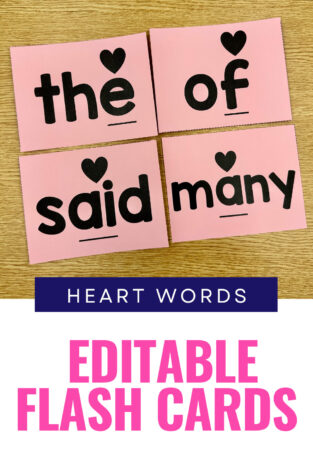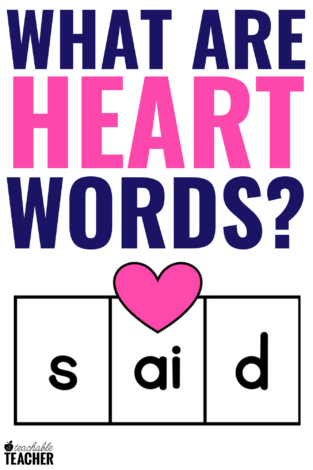Are you looking for heart words flashcards to help practice high frequency words on a daily basis? I have an editable set of high frequency and heart words flashcards I’m excited to show you today!

What are heart words?
Heart words is a science-based method for teaching and learning high frequency words (the most commonly occurring words in the English language) in kindergarten, first grade, second grade, and even third grade.
This method of teaching high-frequency words utilizes orthographic mapping (or word mapping).
While you may have used sight word instruction in the past. With sight words, rote memorization is utilized to memorize long lists of high frequency words.
Heart words focus on utilizing phonics and knowledge of phonics patterns to learn high frequency words, as many are decodable (contrary to popular belief), making it the most effective way to teach high frequency words.
(I learned about this through researching the Science of Reading.)
Because both sight words and heart words are methods for teaching high frequency words, many of the same “word lists” (Dolch list, Fry words. etc.) still apply. However, the words are now divided into three different types.
The Three Types of High Frequency Words (all included in the flashcards)
Decodable High frequency words
These words are fully decodable! For example, the word and. Students can use their understanding of phonics to blend and read this word! YAY! This flashcard can be used to build automaticity in reading and writing.
Heart Words AKA Irregular Words AKA Tricky Words AKA Red Words
Heart words are words that are not fully decodable (thus, being called irregular).
With these words, there is at least one part of the word that has an irregular sound-spelling.
This means that when you’re orthographic mapping (or word mapping), one of the graphemes is not phonetic.
For example: said
There are 3 sounds (so three boxes).
The first sound: /s/ = s
This is phonetic. Students can use their knowledge of phonics (AKA the alphabet to represent the first phoneme (sound in the word).
The second sound: /e/ = ai
This is irregular. “Ai” does not say the short e sound. This is the tricky part, also known as the heart part. With the heart word method, you would draw a little heart above the “ai.”
The third sound: /d/ = d
Again, this is phonetic. Students can use their knowledge of alphabet sounds to spell this part of the word.
In the word said, “ai” is the heart part. This is the only part that students need to memorize, or know by “heart.”
The rest of the word (the first and last sounds) are decodable.
Temporary Heart Words / Flash Words
There are some words that will be a heart word/have a heart part, temporarily.
For example, the high frequency word like, which is on the Dolch sight words list as well as the Fry’s sight word list.
Let’s word map this word.
There are 3 sounds (so draw three boxes).
The first sound: /l/ = l
This is phonetic/it can be sounded out. Great!
Now, for the sake of the illustration, we’re going to skip the last sound.
The last sound: /k/ = k
This is phonetic/it can be sounded out. Great!
But what about that second sound?
The second sound: /i/ = i (consonant) e
This is phonetic, but not to a student who only reads short vowels (CVC) words.
This would only be decodable after students have learned CVCe (or silent e, or magic e, it has many different names. 😉 ).
This means that when you’re teaching this to a student who hasn’t learned CVCe, there is a heart part! The silent e is the heart part.
However, once students learn phonics skill (CVCe), this will no longer be a heart part, or a heart word. Then, it will be fully decodable.
Many teachers refer to these words (phonetic but the skills haven’t been learned) as temporary heart words, or flash words.
Obviously, early readers will have a lot more heart words than more advanced readers.
Why use heart word flashcards?
I love the quote that I read in Lindsay Kemeny’s book 7 Might Mighty Moves:
“Every word wants to be a sight word when it grows up.” – Jan Wasowicz
What does that mean exactly?
It means that any word that can be automatically recognized (not memorized) is a sight word. In order for a reader to be able to instantly retrieve these words (making them sight words), readers need to have mapped its spelling and pronunciation. This allows a reader to store words in their brain for automatic retrieval.
Ideally, every word would become a sight word for our students.
But as we teach young ones how to read, a great place to start is, obviously, words that appear most frequently.
Thus we want to practice orthographically mapping and pronouncing words as much as possible.
I would add that it is also especially important to practice these words in context (like in these decodable passages).
Ways to use Heart Words Flash Cards

If I’m being honest, you can use heart words flash cards any way that you would use sight word flashcards. The difference is, these will have hearts over the irregular parts of words (or temporarily irregular parts of words that haven’t been taught yet!)
With White Boards
Keep them on a binder ring. Use them as call cards and prompt students to word map the word on their whiteboards (or even a page protector) with a dry erase marker! Have them follow orthographic mapping practices by drawing one box for each sound in the word. You know that they will love adding the hearts (where appropriate)!
Daily Drill
Use the flashcards to practice words that have already been explicitly taught as a drill on a daily basis.
Word Wall
Print an extra set of the flashcards and add them to your heart words wall.
Personally, I would add them as students learn them versus having all of them up before being taught.
Editable Flashcards
Since there are flash words/temporary heart words, it’s important that you are able to edit the heart parts of the words on the flash cards.
These heart words flash cards are editable for this reason.
Read Here Next:
What are Heart Words and How Do You Teach Them?

Teaching Heart Words Lessons for Google Slides







I love your articles and find myself getting just caught up in them. I am homeschooling my 2.5 year old grandson how do I know if I am doing too much or not enough for preparation for kindergarten? He loves watching miss Rachel and I feel like I got some a wet direction now! Thank you
Thank you for your kind words! It’s great that you are researching these things for him. He is very fortunate to have you! At 2.5 I would focus on letting him learn through play and just letting him be a toddler! When he is a little closer to kindergarten (4) I would start to look at pre-reading skills and practice those with him. I hope that helps!